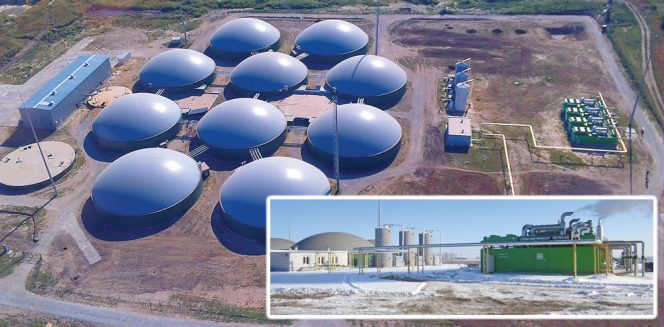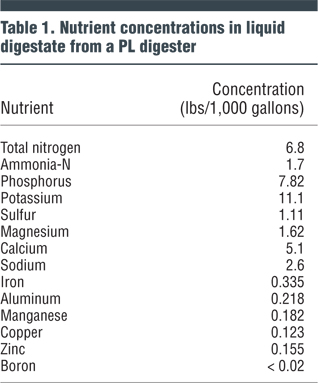Data indicates codigestion with other substrates can improve biogas yield and quality. And most of the organic N is converted to ammonia, which can be converted to ammonium and nitrate by soil microbes. Part II
Craig Coker
BioCycle October 2017

Oril-Leader poultry farm AD system is the largest in Ukraine.According to a U.S. Department of Agriculture estimate, the population of broilers, layers and turkeys in the U.S. (about 10.7 billion birds in total) produce about 550 million tons of manure annually. Some poultry producing regions are in watersheds impaired by excessive nutrients, prompting investigation of alternative methods to manage poultry manure and litter.
Part I of this article, “Poultry Litter Digestion” (September 2017), discussed poultry litter characteristics, and its suitability for anaerobic digestion. Part II covers biogas yield and quality from poultry litter anaerobic digestion (AD), and digestate management. Several case studies are included.
Gas Yield And Quality
When considering biogas production from a poultry litter (PL) slurry, the volatile solids (VS) content of the material is as important as the total solids (TS) content, since it represents the fraction of the solid material that may be transformed into biogas. Although the VS content is an indicator of potential methane production, the specific methane (CH4) yield on a VS basis is not a constant. This is due to the composition of the VS of the waste, which includes both readily degradable organic compounds including lipids, proteins and carbohydrates, as well as more decay-resistant organics, which may include lignocellulosic materials, structural proteins (keratin) and other refractory organics.
Gas volume produced is a function, in part, of hydraulic retention time (HRT) and solids retention time (SRT). One evaluation of a PL digester reported that gas volume increased about 10 percent by increasing HRT from 15 to 30 days, but that methane content of the biogas decreased with increasing HRT, leading to the conclusion that the extra capital cost of the longer HRT (i.e. larger reactors) was not offset by improvement in gas yield or quality (Singh, 2010).
Codigestion with other substrates offers better gas yield and quality potential. An Iranian research study evaluated codigestion of PL and straw and found highest gas yield (0.12 m3 CH4/kgVS) and highest methane content (70.2%) at loading rates of 3.0 kgVS/m3-d, HRT of 15 days and operating temperatures of 35°C (95°F) (Baebee, 2013), but that yield and quality dropped off significantly at higher loading rates and at lower temperatures. A German AD study using poultry manure only with ammonia stripping in a mesophilic reactor determined gas yields of 0.62 m3 CH4/kgVS at loading rates of 3.4 kgVS/m3-d but needed an HRT of 77 days to reach those levels (Belostotskiy, 2013).
It is unclear whether dry fermentation AD of poultry litter offers more yield and quality potential than more traditional wet AD, as one study of a dry fermentation reactor using PL as a substrate reported gas quality of only 36 to 40 percent CH4 content with more methane in the reservoir holding the liquid percolate (43%) than in dry fermentation reactor (16%) (Rajagopal, 2016).
Digestate Management
The high nitrogen content of poultry manure can cause operational challenges during AD, but the nutrient is beneficial in the digestate product as most of the organic nitrogen is converted to ammonia, which can be converted to ammonium and nitrate by soil microbes. Other plant nutrients found in PL digestate (potassium, phosphorus, calcium, magnesium, and iron) are conserved in the AD process and concentrated in the solid fraction following digestate dewatering.
However, areas with high levels of soil phosphorus from previous land applications of manures or sludges may not be suitable for use of digestate as a source of plant nutrients due to high P concentrations in the dewatered solids (≈ 4.0 g P/kg digestate) (Singh, 2010). An evaluation of the digestate from a PL digester found the nutrient content shown in Table 1 (Evans, 2009).
Case Studies
Brinson Farms
Brinson Farms in Prentiss, Mississippi operates 10 commercial broiler houses that are heated using biomass boilers. The farm installed an anaerobic digester in 2006. Digester feedstocks include litter as well as municipal yard trimmings. “In my view, the key to digesting poultry manure is to keep the ammonia in the ionized form,” notes John Logan, owner of Brinson Farms. ”I have taken steps as well to acclimatize the bacteria in my digesters to higher levels of ammonia.” Keeping ammonia in the ionized form (ammonium) is largely a matter of keeping pH in the substrate around 7 or lower.
Poultry manure is diluted to less than 8 percent TS before being fed into a two-stage digester system. Stage 1 is a thermophilic continuous-stirred tank reactor (CSTR) reactor; Stage 2 is a mesophilic CSTR system. HRTs are 18 days in Stage 1 and 25 to 30 days in Stage 2. Both reactors are heated by the biogas but parasitic energy loads are only 8 percent due to good insulation of the tanks.
One ton of chicken litter produces more than 5 million BTUs of biogas, according to Logan. Hydrogen sulfide and some carbon dioxide is removed from the biogas using a lime-based scrubber, then chilled to remove moisture. The biogas has 80 to 85 percent methane content and is used in multiple applications — electricity generation for the farm, in boilers to heat water for the digestion process, and in dual-fuel biomass boilers to heat water for heat exchange in the broiler houses when biomass sources are low. Excess power is sold to the Mississippi electric grid at 3.5 cents/kilowatt-hour.
Two other significant products from the digester include liquid fertilizer (with a N-P-K value of approximately 5-2-3) that is used as dilution fluid for the manure and residual solids, which are incorporated into the farm’s composting operation. Solar panels assist in heating water for the biomass boilers and the digester. The simple payback period for the on-farm poultry litter digester system was approximately 5 years (Miles, 2013). Logan has patented the Brinson Farm digester configuration and has since built other systems in four states.
Ductor Oy
Ductor Oy, a Finnish AD technology provider, commissioned a pilot poultry manure digester facility in Tuorla, Finland in 2016. The system starts by liquefying the manure to 10 percent TS, then biologically converting the organic nitrogen to ammonia in a fermentation tank (5 day retention time at 52oC.). Next the slurry is dewatered with a decanter (33% TS, less than 0.5% TS in the effluent); ammonia is stripped from the effluent with sulfuric acid, and the ammonia-depleted liquid is digested in a CSTR.
HRT of the system is 21 days, after which digestate is dewatered. The effluent is recycled to liquefy the manure. Solids are spread on fields as a fertilizer/soil enhancement agent. “We use the effluent from digestate separation to dilute the incoming feed,” explains Ilkka Virkajärvi, Chief Technical Officer of Ductor Oy. “This slurry contains about 25 percent of the nitrogen found in the litter, or around 4 to 4.5 kg/l. Even though we are reusing this effluent, our calculations show that salt buildup will not be a problem.”
The pilot plant has the capacity to digest 1,400 tons/year of poultry manure, producing 266,000 cubic meters (9.3 million cubic feet) of biogas with 65 to 70 percent methane content, 115 tons of ammonium sulfate and 640 tons of fertilizer with a N-P-K value of 3.1-2.6-4.7.
Oril-Leader
Oril-Leader is the largest integrated poultry farm in Ukraine, involved with all aspects of poultry agriculture. In 2012, it commissioned an anaerobic digester in Yelyzavetivka, for poultry manure and slaughterhouse wastes using technology from Nijhuis Industries. The $15 million plant, which reached full capacity in 2013, manages 170 tons/day of chicken manure, 60 tons/day of dissolved air flotation sludge, 100 tons/day of wash water from poultry barns, 100 tons/day of silage, and 500 tons/day of wastewater. Twenty million cubic meters of biogas are produced annually, and used to make 5 megawatt-hours of power continuously along with 119,000 million BTUs of recovered heat. The plant uses the AECOMIX™-TAURUS CSTR technology from Nijhuis Industries, and includes a mixing tank, four primary digesters, six secondary digesters, three screw presses, three hydrogen sulfide scrubbers, and five combined heat and power generators.
Craig Coker is a Senior Editor at BioCycle and CEO of Coker Organics Recycling (www.cokercompost.com). He can be reached at ccoker@jgpress.com.











